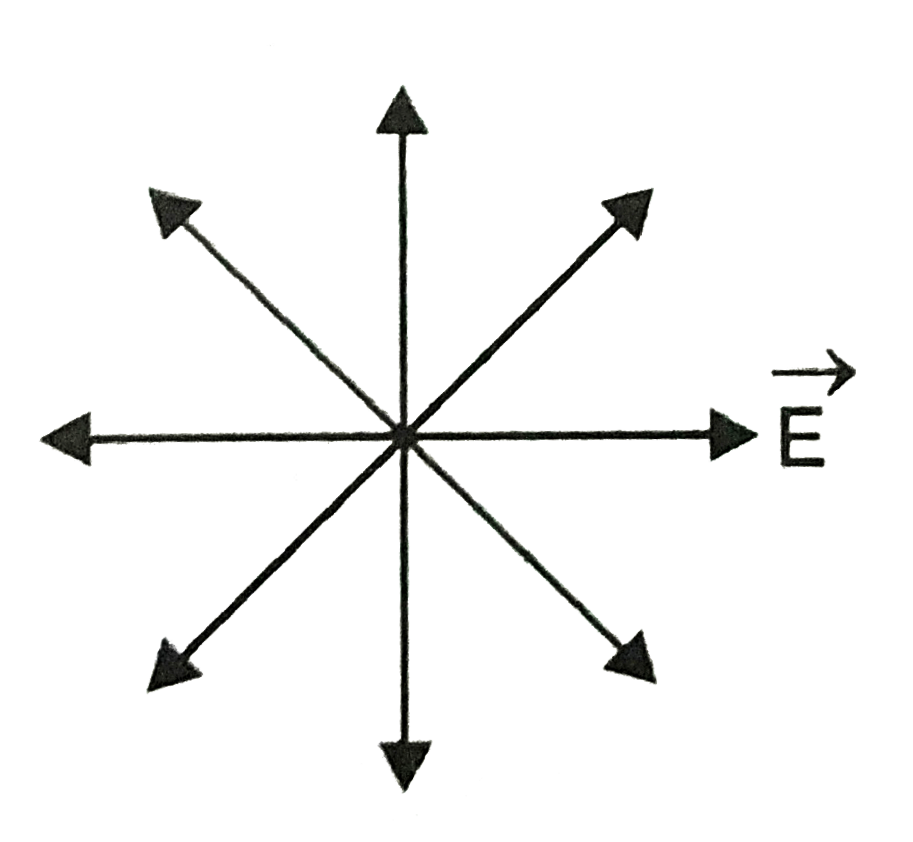Distinguish between unpolarised light and linearly polarised light. How does one get linearly polarised light with the help of a polaroid ?
An unpolarised light consists of many independent waves, whose planes of vibration are randomly oriented about the direction of propagation as shown in Fig.

Light is generally represented by electric field vector →E, called light vector.
Linearly polarised light is that in which vibrations of electric field are confined in one direction in a plane perpendicular to the direction of propagation of light.
when unpolarised light is passed thorugh a tounmaline crystal cut with its face parallel to the crystallographic axis, only those vibrations of light pass through the crystal, which are parallel to the axis. All other vibrations are absorbed and we get linearly polarised light.
Topper's Solved these Questions
- OPTICSBOOK - PRADEEPCHAPTER - OPTICSEXERCISE - Very short answer questions (Questions)
1 Videos
- OPTICSBOOK - PRADEEPCHAPTER - OPTICSEXERCISE - Short answer questios
1 Videos
- OPTICSBOOK - PRADEEPCHAPTER - OPTICSEXERCISE - Example
1 Videos
- MAGNETIC EFFECT OF CURRENT AND MAGNETISMBOOK - PRADEEPCHAPTER - MAGNETIC EFFECT OF CURRENT AND MAGNETISMEXERCISE - Competition Focus (Multiple Choice Questions)
2 Videos
Similar Questions
(a) Distinguish between unpolarised light and linearly polarised light. How does one get linearly polarised light with the hel of a polaroid ?
(b) A narrow beam of unpolarised light of intensity I0 is incident on a polaroid P1. The light transmitted by it is then incident on a second polaroid P2 with its pass axis making angle of 60∘ relative to the pass axis of P1. find the intensity of the light transmitted by P2.
View Solution(a) Distinguish between unpolarized light and linearly polarized light. How does one get linearly polarised light with the help of a plaroid ?
(b) A narrow beam of unpolarised light of intensity I0 is incident on a polaroid P1. The light transmitted by it is then incident on a second polaroid P2 with its pass axis making angle of 60∘ relative to the pass axis of P1. Find the intensity of the light transmitted by P2.
View Solution(a) Distinguish between unpolarized light and linearly polarized light. How does one get linearly polarised light with the help of a plaroid ?
(b) A narrow beam of unpolarised light of intensity I0 is incident on a polaroid P1. The light transmitted by it is then incident on a second polaroid P2 with its pass axis making angle of 60∘ relative to the pass axis of P1. Find the intensity of the light transmitted by P2.
View Solution(a) Distinguish between unpolarized light and linearly polarized light. How does one get linearly polarised light with the help of a plaroid ?
(b) A narrow beam of unpolarised light of intensity I0 is incident on a polaroid P1. The light transmitted by it is then incident on a second polaroid P2 with its pass axis making angle of 60∘ relative to the pass axis of P1. Find the intensity of the light transmitted by P2.
View Solutionhow can one distinguish between an unpolarised light beam and a linearly polarised light beam using a polaroid ?
View SolutionDistinguish between unpolarised and plane polarised light. An unpolarised light is incident on the boundary between two transparent media. State the consition when the reflected wave is totally plane polarised. Find out the expression for the angle of incidence in this case.
View SolutionDistinguish between unpolarised and plane polarised light. An unpolarised light is incident on the boundary between two transparent media. State the condition when the reflected wave is totally plane polarised. Find out the expression for the angle of incidence in this case.
View SolutionDifferentiate between polarised and un-polarised light. How are these represented ?
View SolutionIn what way is plane polarised light different from an unpolarised light ?
View SolutionLight waves are electromagnetic waves and hence transverse in nature. The electric field in a light wave propagating in free space is perpendicular to the direction of propagation. But there are infinite number of directions perpendicular to the direction of propagation. but there are infinite number of directions perpendicular to the direction of propagation of light. for example if light propagates along x-axis, the electric field may be along y-axis or along the z-axis or along any direction in y-z plane in the ordinary light. However, if electric field →E remains parallel to a fixed direction (say y-axis) then such light is called linearly polarised light.
There are several methods to produce polarised light from the unpolarised light. now-a-days polaroid sheets are commonly used to produce linearly polarised light. a polaroid has long chain of hydrocarbons which become conducting at optical frequencies. when light falls normally on the polaroid sheet, the →E parallel to the chains is absorbed in setting up electric currents in the chains but →E perpendicular to the chain gets transmitted. so, light on passing through the polaroid i.e., the transmitted light become linearly polarised with →E parallel to the transission (pass) axis of polaroid.
If linearly polarised light of intensity 'I' is incident on another polaroid whose pass axis is inclined at an angle θ from pass axis of first polaroid (or transmission axis of →E of linearly polarised light) the intensity of transmitted light It is given as:
It=Icos2θ.
Q. What is linearly polarised light ?
View Solution
